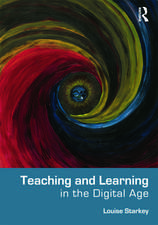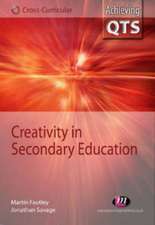Getting to the Core of Literacy for History/Social Studies, Science, and Technical Subjects, Grades 6–12
Autor Vicky M. Giouroukakis, Maureen Connollyen Limba Engleză Paperback – 16 dec 2013
Preț: 250.77 lei
Nou
Puncte Express: 376
Preț estimativ în valută:
47.99€ • 51.31$ • 40.01£
47.99€ • 51.31$ • 40.01£
Carte tipărită la comandă
Livrare economică 17 aprilie-01 mai
Preluare comenzi: 021 569.72.76
Specificații
ISBN-13: 9781452255446
ISBN-10: 145225544X
Pagini: 264
Dimensiuni: 216 x 279 x 16 mm
Greutate: 0.75 kg
Ediția:New.
Editura: SAGE Publications
Colecția Corwin
Locul publicării:Thousand Oaks, United States
ISBN-10: 145225544X
Pagini: 264
Dimensiuni: 216 x 279 x 16 mm
Greutate: 0.75 kg
Ediția:New.
Editura: SAGE Publications
Colecția Corwin
Locul publicării:Thousand Oaks, United States
Recenzii
“This hands-on, research-based guide presents classroom-tested lessons and ideas for modifying existing lessons to meet the challenges of the CCSS. The authors also emphasize 21st century learning skills such as collaboration, critical thinking, and creativity, with technology and life and career skills components. Getting to the Core clearly breaks down key tenets of the CCSS, deftly addressing both timely topics (cyberbullying, social justice, and graphic novels), as well as more traditional secondary English experiences (Macbeth, Of Mice and Men, the Gettysburg Address, and The House on Mango Street). This melding cements the important place this book deserves on the shelf of any current or aspiring English educator.”
Cuprins
Introduction: How to Use This Book
Overview of Chapters
Lesson Format
Lesson Selection
Best Practices
Part I. Reading Standards for Literacy in History/Social Studies, Science, and Technical Subjects
1. Understanding the CCSS: An Overview
What Are the CCSS for Literacy in the Content Areas?
How Can We Use Backward Design to Create Curriculum that Addresses the CCSS for Literacy in the Content Areas?
How Do the CCSS for Literacy in the Content Areas and Backwards Design Relate to the Theories of Dewey, Bloom and Gardner?
2. The Benefits of the CCSS for the Teaching of Reading in the Content Areas
3. Reading Lessons in History/Social Studies 6-12
Key Ideas and Details
Nationalism: THe Good, the Bad, the Ugly (U.S. History, Grades 6-8)
Craft and Structure
Social Causes of New Imperialism (World History, Grades 9-10)
Integration of Knowledge and Ideas
Vietnam: The Human Face of an Inhumane Time (US History, Grades 11-12)
4. Reading Lessons in Science and Technical Subjects
Key Ideas and Details
Bonus Science Articles (Biology, Grades 11-12)
Craft and Structure
Vocabulary Videos (Computer Apps, Grades 9-10)
Integration of Knowledge and Ideas
Continental Drift (Earth Science, Grades 6-8)
Part II. Writing Standards for Literacy in History/Social Studies, Science, and Technical Subjects
5. The Benefits of the CCSS for the Teaching of Writing in the Content Areas
6. Argument Writing Lessons
Social Studies
Mock Trial: Native Americans & European Colonization ( U.S. History, Grades 6-8)
Science
Boyle's Law (Chemistry, Grades 9-10)
Technical Subjects
Fantasy Basketball (Sports Marketing, Grades 11-12)
7. Informative/Explanatory Writing Lessons
Technical Subjects
Math in Everyday Life (Math, Grades 6-8)
Science
Earth Day (Earth Science, Grades 9-10)
Social Studies
The Montgomery Bus Boycott (U.S. History, Grades 11-12)
8. Ensuring Success With the CCSS for Literacy in the Content Areas
What are Best Practices for Addressing the CCSS for Literacy in the Content Areas?
Success Stories Involving Content Area Teachers Working Together
Accessing Support Through Technology
Ten Tips for Getting to the Core of the Common Core for Literacy in the Content Areas
Conclusion
Overview of Chapters
Lesson Format
Lesson Selection
Best Practices
Part I. Reading Standards for Literacy in History/Social Studies, Science, and Technical Subjects
1. Understanding the CCSS: An Overview
What Are the CCSS for Literacy in the Content Areas?
How Can We Use Backward Design to Create Curriculum that Addresses the CCSS for Literacy in the Content Areas?
How Do the CCSS for Literacy in the Content Areas and Backwards Design Relate to the Theories of Dewey, Bloom and Gardner?
2. The Benefits of the CCSS for the Teaching of Reading in the Content Areas
3. Reading Lessons in History/Social Studies 6-12
Key Ideas and Details
Nationalism: THe Good, the Bad, the Ugly (U.S. History, Grades 6-8)
Craft and Structure
Social Causes of New Imperialism (World History, Grades 9-10)
Integration of Knowledge and Ideas
Vietnam: The Human Face of an Inhumane Time (US History, Grades 11-12)
4. Reading Lessons in Science and Technical Subjects
Key Ideas and Details
Bonus Science Articles (Biology, Grades 11-12)
Craft and Structure
Vocabulary Videos (Computer Apps, Grades 9-10)
Integration of Knowledge and Ideas
Continental Drift (Earth Science, Grades 6-8)
Part II. Writing Standards for Literacy in History/Social Studies, Science, and Technical Subjects
5. The Benefits of the CCSS for the Teaching of Writing in the Content Areas
6. Argument Writing Lessons
Social Studies
Mock Trial: Native Americans & European Colonization ( U.S. History, Grades 6-8)
Science
Boyle's Law (Chemistry, Grades 9-10)
Technical Subjects
Fantasy Basketball (Sports Marketing, Grades 11-12)
7. Informative/Explanatory Writing Lessons
Technical Subjects
Math in Everyday Life (Math, Grades 6-8)
Science
Earth Day (Earth Science, Grades 9-10)
Social Studies
The Montgomery Bus Boycott (U.S. History, Grades 11-12)
8. Ensuring Success With the CCSS for Literacy in the Content Areas
What are Best Practices for Addressing the CCSS for Literacy in the Content Areas?
Success Stories Involving Content Area Teachers Working Together
Accessing Support Through Technology
Ten Tips for Getting to the Core of the Common Core for Literacy in the Content Areas
Conclusion
Notă biografică
Descriere
Helps teachers develop a clear understanding of the the Common Core State Standards for Reading and Writing in History/Social Studies, Science, and the Technical Subjects












